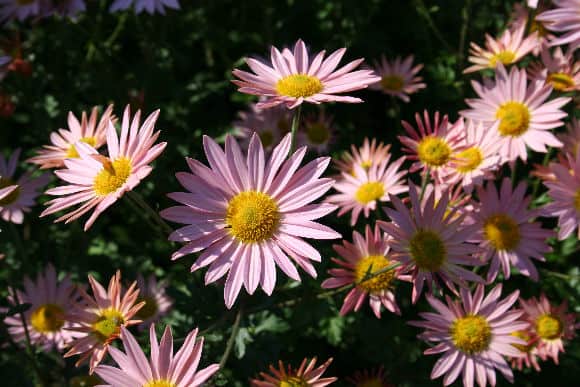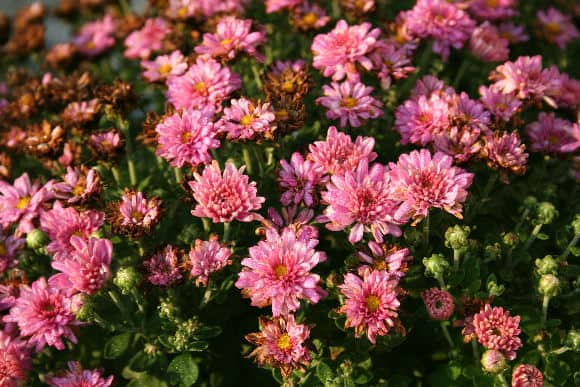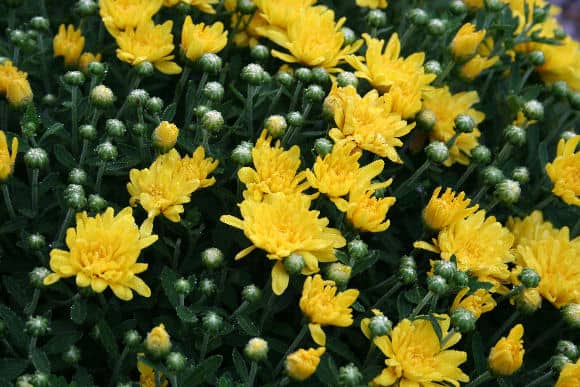There are many types of chrysanthemums. The National Chrysanthemum Society lists 13 classes of mums that competitors can grow and show, but Purdue University’s Horticultural Extension Office reduces the number of types of chrysanthemums for the home garden to eight types. Most types come in a variety of colors, including yellow, white, pink, and bronze. The name chrysanthemum actually means “golden flower,” reminding gardeners of the flower’s wild cousins in its native Asia and Europe.
The Eight Types of Chrysanthemums
According to the plant tip sheet provided by Purdue University, there are eight types of chrysanthemums suitable for the home garden. These include:
- Single: Single-type chrysanthemums have a flat center and one to five rows of petals radiating out from the center, which gives them the appearance of daisies.
- Cushion: Cushion mums grow low, bush-like foliage. Plants produce small, quarter-sized chrysanthemum flowers.
- Pompom: As the name suggests, the flowers resemble small pompoms on the end of each stalk.
- Anemone: Anemone mums feature a raised, dome-like center. The petals look a lot like the single mums. You’re more likely to find anemone mums available for sale at online nurseries or small local nurseries.
- Spoon: Spoon mums feature small, cup-like ends on the petals. Literally, each petal on the central flower disk resembles a spoon.
- Spider: Spiders mums offer curling, curved petals with hooks on the end that make the flowers resembled crazy-legged spiders.
- Quill: Quill mums have long, straight petals that are rolled naturally into tubes, like an old-fashioned quill pen. Unfortunately, very few of these cultivars are hardy. If you’re buying a quill mum at a garden center, check the tag. A bit of extra mulch may protect plants and nurture them through the winter.
- Decorative: Decorative mums have incurved or reflex petals. What does that mean? The petals on these mums either curve upwards and back towards the flower center (incurved) or down and away from the flower center (reflex). While you’re more likely to find such mums among the show and exposition flowers sold online, you can find some at specialty stores nationwide.

Caring for Hardy Mums for the Garden
Growing great mums starts with buying healthy plants.
Look for single, anemone, or pompom mums if you’re seeking hardy mums for the garden. While others in the list of eight may be fine, those among the first three types are usually the hardiest. They bloom before the first frost, and blossoms often last through several touches of frost, depending on your gardening zone.
Planting
Plant mums in the spring as soon as all danger of frost is past. Choose a bright location. I prefer to start garden mums from plants or cuttings. Plants can be placed directly in the ground. However, cuttings should be grown in pots or containers until they show signs of new growth. Then, they can be moved into the garden soil.
Light Requirements
Mums need full sunlight, defined as six or more hours of sunshine per day. You can grow them in pots and keep pots on your front porch, front staircase or deck.
These plants tolerate partial shade as well. But, they may not bloom as heavily if they are grown in partial sunlight.

Soil and Fertilizer
Mums grown directly in the garden soil require fertile, well-drained soil. They prefer a pH of 6.5 – 6.7. Adding good organic compost to the soil adds natural nutrients.
Mums benefit from fertilizer, and one or two applications in the summertime of 10-10-10 or 20-20-20 fertilizer help the plant thrive. If you’d prefer to use organic fertilizer, make compost tea or use good, well-rotted manure.
Pruning
Pruning mums is called pinching. To pinch mums, remove about 1–2 inches from the tips of the plant to encourage it to bloom later in the season. If you forget to prune or pinch your mums in the spring, they’ll bloom but may surprise you with summertime blossoms.
Pinching Mums
To prune or pinch mums, cut off the tips about 1–2 inches. Prune mums the first week of May. Then prune them again the second week of July. They will reward you with blossoms throughout the fall. Cut off some blooms to bring indoors, or enjoy the many types of chrysanthemums in your flower garden.

Water Requirements
Like most flowers, mums need plenty of water – about an inch per week. If you aren’t getting sufficient rain, water them with a hose, sprinkler, or watering can.
Chrysanthemum Shows
Looking at pictures on the National Chrysanthemum Society website brought back many fond childhood memories of Friday night setups at Farmingdale Community College, helping my dad place his show mums in old glass milk bottles at the agricultural college. Dad would hand me the bottle and a green paper sleeve and his neatly typed entry card, and I would bring each out to the show table.
Over the long weekend of the mum show, my dad would be on hand to help out. I’d stand with a clipboard near the doorway. My dad asked me to count the number of visitors coming into the round agricultural college auditorium. He taught me how to do a tick list, or make the slash marks to count visitors. Now that I think about it, he probably did that so that I wouldn’t get in trouble and bother anyone.
I’d wander for hours looking at all the beautiful mums. My favorite displays were the ones that showed a dining room scene. There would be gorgeous floral displays on the center of the table. I always wanted to enter that contest. Maybe I can, someday!




